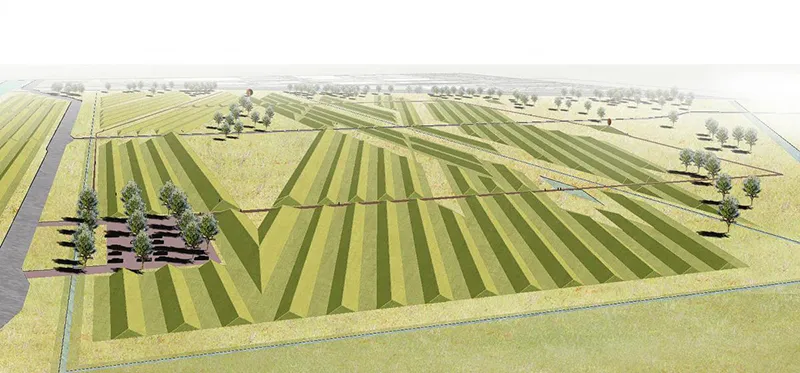This Crazy Land Art Deflects Noise From Amsterdam’s Airport
To drown out flight noise, the Amsterdam Airport turned to large-scale landscaping
/https://tf-cmsv2-smithsonianmag-media.s3.amazonaws.com/filer/95/01/9501f925-3cec-4275-8a1f-6559c3013261/tumblr_n8fyn3m7io1tzpodro1_1280.jpg)
To the southwest of Amsterdam’s Schiphol Airport, just past the edge of the runway, there’s a series of hedges and ditches laid out like interlocking diamonds.
The 80-acre green space is the Buitenschot Land Art Park. Its trenches and ridges hold bike paths and sports fields, but these recreational features are a bonus. Its main purpose is to deflect ground noise, the low-frequency drone that planes make when they take off and land.
Schiphol, which is just south of downtown Amsterdam, is one of the busiest airports in the world. It’s a KLM Royal Dutch Airlines hub, and a major stopping point for cargo going to Asia. More than 1,600 flights go in and out each day. To put this into perspective, Atlanta’s Hartsfield-Jackson, the busiest in the U.S. and the world, sees about 2,500 a day. Schiphol is busy, and it is loud.
When the Dutch military first built a landing strip there in 1916, they chose the site because the polder, what they call the low lying area it sits in, is the kind of terrain that’s prime for landing airplanes—flat, wide and open. But, because of those qualities it also functions as a giant megaphone, amplifying the sound of planes across the area.
People in the surrounding neighborhoods started complaining about the noise, when the Polderban runway, the longest and newest at the airport, was built in 2003. Residents could hear the din more than 18 miles away, and it was incessant.
Ground noise is tough to control, because of the way it travels. The sound waves aren’t easily deflected by traditional sound barriers, like the concrete walls you see by the side of the highway, because the low frequency, long wavelength sound skips over single barriers. So the airport had to come up with clever ways to divert the noise. In 2008, they brought in the Netherlands Organization for Applied Scientific Research [TNO] to conduct a study. The research institute found that in the fall, after the surrounding fields had been plowed, noise levels decreased significantly. The farmer’s furrows, because they had multiple ridges to absorb the sound waves, deflected the sound and muted the noise.

The Netherlands has a long history of shaping the physical environment to suit citizens’ needs—Amsterdam, for instance, is built around a system of manmade canals. So, a large-scale landscaping project at Schiphol was not out of line. Officials decided to reimagine the land surrounding the airport to drown out as much of the ground noise as possible. They brought on H+N+S Landscape Architects and artist Paul De Kort, who designed the maze-like park.
De Kort drew on 17th-century Chladni patterns. In his experiments on acoustics, German scientist Ernst Chladni strew sand or salt across a metal plate and then brushed a fiddlestick along it to create vibrations that caused the grains to set up in ridges. The artist also studied historic farming techniques in the local Harlemmermeer area to come up with his design. “I tried to create a symbiosis between a purely functional landscape of horizontal ridges and a pleasant environment,” he says.
De Kort used GPS to plow 150 perfectly straight and symmetrical furrows with six foot high ridges between them. In the valleys, he built mini parks and bike paths. He also incorporated art pieces that drew on the history of the project, like “Listening Ear,” a parabolic dish that is large enough to stand in. The sculpture amplifies the ambient sound, a nod to the park’s purpose of deflecting that noise.
Finished in October 2013, Buitenschot cut the decibel level of the ambient noise in half almost immediately. They set up 35 noise monitoring points around the region, and when tested in 2014, the volume at each location did not exceed the desired level. The airport is trying to cut it down even further by changing when certain planes can take off and requiring airlines to update their fleets.
A NASA study of the Schiphol project found that a multi-faceted noise control plan was important, because they worried that just addressing noise on only one level, like cutting down the number of flights, might have negative economic impacts. "Noise management plans have the potential to severely disrupt interstate, or international, commerce and exert strong negative pressure on the aviation industry," the study said.
Airport noise is currently a contentious issue. There have been noise-related protests at both LaGuardia and JFK in New York City, and the FAA is undertaking its first airport noise study in 25 years. Other busy airports, like the one in Melbourne and London’s Gatwick, are putting in natural sound barriers, similar to the Schiphol ones.
Planners in places other than airports are also turning to similar landscape-based noise control solutions. In Delhi, for instance, residents of the Panchsheel Park neighborhood where noise volumes exceed safe levels day and night, have been asked by the National Green Tribunal, a division of the Parliament, to grow hedges to try to mitigate the din.
A 10-year study from the U.S. National Parks Service, released recently in February set up sound meters at 600 different wilderness sites and found that every single location was impacted by ambient noise. Kurt Fristrup, the scientist who led the study, estimates that noise pollution is doubling every 20 years. Measures like the one taken at Schiphol may slow that rate down.
For De Kort, it’s a pity that airline passengers won’t actually get to enjoy his art. “The ground sound spreads behind the plane that’s taking off, so in fact you fly away in the other direction,” he says. “You won’t be able to actually see the area from the air."
/https://tf-cmsv2-smithsonianmag-media.s3.amazonaws.com/accounts/headshot/DSC_0196_2.JPG)
/https://tf-cmsv2-smithsonianmag-media.s3.amazonaws.com/accounts/headshot/DSC_0196_2.JPG)